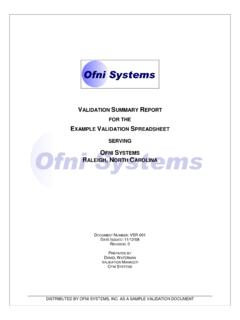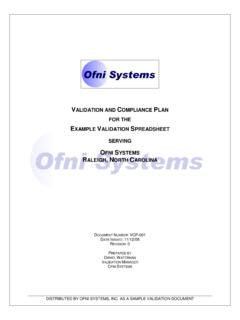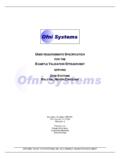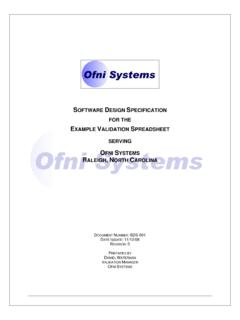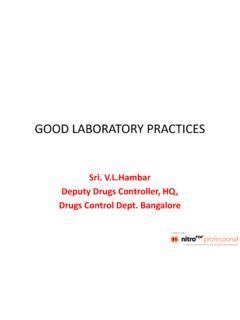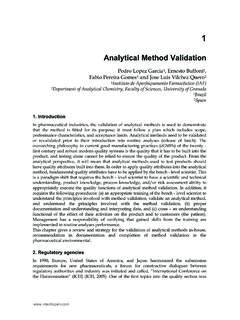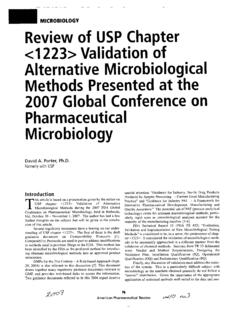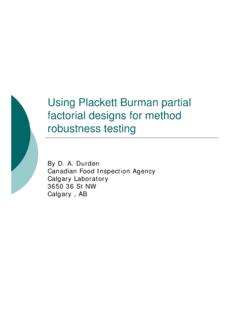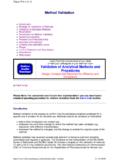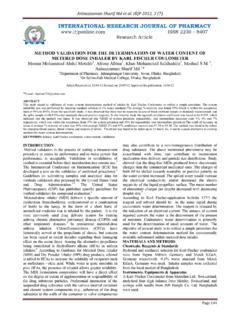Transcription of VALIDATION OF COMPENDIAL PROCEDURES
1 USP 36 General Information / 1225 VALIDATION of COMPENDIAL Procedures1formance characteristics of the procedure meet the require-ments for the intended analytical applications. Typical ana- 1225 VALIDATION OFlytical performance characteristics that should be consideredin the VALIDATION of the types of PROCEDURES described in thisCOMPENDIAL PROCEDURES document are listed in Table 1. Because opinions may differwith respect to terminology and use, each of the perfor-mance characteristics is defined in the next section of thischapter, along with a delineation of a typical method orTest PROCEDURES for assessment of the quality levels ofmethods by which it may be measured. The definitions referpharmaceutical articles are subject to various test results. The description of the analytical procedureAccording to Section 501 of the Federal Food, Drug, andshould define what the test results for the procedure are.
2 AsCosmetic Act, assays and specifications in monographs ofnoted in ISO 5725-1 and 3534-1, a test result is the valuethe United States Pharmacopeia and the National Formularyof a characteristic obtained by carrying out a specified testconstitute legal standards. The Current Good Manufacturingmethod. The test method should specify that one or a num-Practice regulations [21 CFR (a)] require that testber of individual measurements be made, and their average,methods, which are used for assessing compliance of phar-or another appropriate function (such as the median or themaceutical articles with established specifications, must meetstandard deviation), be reported as the test result. It mayproper standards of accuracy and reliability. Also, accordingalso require standard corrections to be applied, such as cor-to these regulations [21 CFR (a)(2)], users of analyti-rection of gas volumes to standard temperature and pres-cal methods described in USP NF are not required to vali-sure.
3 Thus, a test result can be a result calculated from sev-date the accuracy and reliability of these methods, buteral observed values. In the simple case, the test result is themerely verify their suitability under actual conditions of value itself. A test result also can be, but needRecognizing the legal status of USP and NF standards, it isnot be, the final, reportable value that would be comparedessential, therefore, that proposals for adoption of new orto the acceptance criteria of a specification. VALIDATION ofrevised COMPENDIAL analytical PROCEDURES be supported byphysical property methods may involve the assessment ofsufficient laboratory data to document their models. However, the typical analytical charac-The text of this information chapter harmonizes, to theteristics used in method VALIDATION can be applied to theextent possible, with the Tripartite International Conferencemethods derived from the use of the chemometric Harmonization (ICH) documents VALIDATION of AnalyticalProcedures and the Methodology extension text, which areTable 1.
4 Typical Analytical Characteristicsconcerned with analytical PROCEDURES included as part of re- Used in Method Validationgistration applications submitted within the EC, Japan, andthe TO THE COMPENDIAS pecificitySubmissions to the compendia for new or revised analyti-Detection Limitcal PROCEDURES should contain sufficient information to en-Quantitation Limitable members of the USP Council of Experts and its ExpertLinearityCommittees to evaluate the relative merit of proposed pro-Rangecedures. In most cases, evaluations involve assessment ofRobustnessthe clarity and completeness of the description of the ana-lytical PROCEDURES , determination of the need for the proce-The effects of processing conditions and potential for seg-dures, and documentation that they have been appropri-regation of materials should be considered when obtainingately validated.
5 Information may vary depending upon thea representative sample to be used for VALIDATION oftype of method involved. However, in most cases a will consist of the following the case of COMPENDIAL PROCEDURES , revalidation mayRationale This section should identify the need for thebe necessary in the following cases: a submission to the USPprocedure and describe the capability of the specific proce-of a revised analytical procedure; or the use of an estab-dure proposed and why it is preferred over other types oflished general procedure with a new product or raw mate-determinations. For revised PROCEDURES , a comparisonrial (see below in Data Elements Required for VALIDATION ).should be provided of limitations of the current compendialThe ICH documents give guidance on the necessity forprocedure and advantages offered by the proposed proce-revalidation in the following circumstances: changes in of the drug substance; changes in the compositionProposed Analytical Procedure This section shouldof the drug product; and changes in the analyticalcontain a complete description of the analytical detailed to enable persons skilled in the art toChapter 1225 is intended to provide information that isreplicate it.
6 The write-up should include all important opera-appropriate to validate a wide range of COMPENDIAL analyti-tional parameters and specific instructions such as prepara-cal PROCEDURES . The VALIDATION of COMPENDIAL procedurestion of reagents, performance of system suitability tests,may use some or all of the suggested typical analytical char-description of blanks used, precautions, and explicit formu-acteristics used in method VALIDATION as outlined in Table 1las for calculation of test categorized by type of analytical method in Table 2. ForData Elements This section should provide thoroughsome COMPENDIAL PROCEDURES the fundamental principles ofand complete documentation of the VALIDATION of the analyt- VALIDATION may extend beyond characteristics suggested inical procedure. It should include summaries of experimentalChapter 1225 . For these PROCEDURES the user is referred todata and calculations substantiating each of the applicablethe individual COMPENDIAL chapter for those specific analyti-analytical performance characteristics.
7 These characteristicscal VALIDATION characteristics and any specific validationare described in the following of an analytical procedure is the process bywhich it is established, by laboratory studies, that the per-2 1225 VALIDATION of COMPENDIAL PROCEDURES / General InformationUSP 36 PRECISIONA nalytical Performance CharacteristicsDefinition The precision of an analytical procedure isthe degree of agreement among individual test results whenthe procedure is applied repeatedly to multiple samplings ofACCURACYa homogeneous sample. The precision of an analytical pro-cedure is usually expressed as the standard deviation or rela-Definition The accuracy of an analytical procedure istive standard deviation (coefficient of variation) of a series ofthe closeness of test results obtained by that procedure tomeasurements. Precision may be a measure of either thethe true value.
8 The accuracy of an analytical proceduredegree of reproducibility or of repeatability of the analyticalshould be established across its range. [A note on terminol-procedure under normal operating conditions. In this con-ogy: The definition of accuracy in 1225 and ICH Q2 corre-text, reproducibility refers to the use of the analytical proce-sponds to unbiasedness only. In the International Vocabularydure in different laboratories, as in a collaborative study. In-of Metrology (VIM) and documents of the International Or-termediate precision (also known as ruggedness) expressesganization for Standardization (ISO), accuracy has a differ-within-laboratory variation, as on different days, or with dif-ent meaning. In ISO, accuracy combines the concepts offerent analysts or equipment within the same (termed trueness ) and precision.]Repeatability refers to the use of the analytical procedurewithin a laboratory over a short period of time using theDetermination In the case of the assay of a drug sub-same analyst with the same , accuracy may be determined by application of theanalytical procedure to an analyte of known purity ( , aDetermination The precision of an analytical procedureReference Standard) or by comparison of the results of theis determined by assaying a sufficient number of aliquots ofprocedure with those of a second, well-characterized proce-a homogeneous sample to be able to calculate statisticallydure, the accuracy of which has been stated or estimates of standard deviation or relative standardIn the case of the assay of a drug in a formulated prod-deviation (coefficient of variation).
9 Assays in this context areuct, accuracy may be determined by application of the ana-independent analyses of samples that have been carriedlytical procedure to synthetic mixtures of the drug productthrough the complete analytical procedure from samplecomponents to which known amounts of analyte have beenpreparation to final test within the range of the procedure. If it is not possibleThe ICH documents recommend that repeatability shouldto obtain samples of all drug product components, it maybe assessed using a minimum of nine determinations cover-be acceptable either to add known quantities of the analyteing the specified range for the procedure ( , three con-to the drug product ( , to spike ) or to compare resultscentrations and three replicates of each concentration) orwith those of a second, well-characterized procedure, theusing a minimum of six determinations at 100% of the testaccuracy of which has been stated or the case of quantitative analysis of impurities, accuracyshould be assessed on samples (of drug substance or drugSPECIFICITY product) spiked with known amounts of impurities.
10 Where itis not possible to obtain samples of certain impurities ordegradation products, results should be compared withDefinition The ICH documents define specificity as thethose obtained by an independent procedure. In the ab-ability to assess unequivocally the analyte in the presence ofsence of other information, it may be necessary to calculatecomponents that may be expected to be present, such asthe amount of an impurity based on comparison of its re-impurities, degradation products, and matrix to that of the drug substance; the ratio of the re-Lack of specificity of an individual analytical procedure maysponses of equal amounts of the impurity and the drug sub-be compensated by other supporting analytical (relative response factor) should be used if known.[NOTE Other reputable international authorities (IUPAC,Accuracy is calculated as the percentage of recovery byAOAC-I) have preferred the term selectivity, reservingthe assay of the known added amount of analyte in the specificity for those PROCEDURES that are completely selec-sample, or as the difference between the mean and the ac-tive.]
